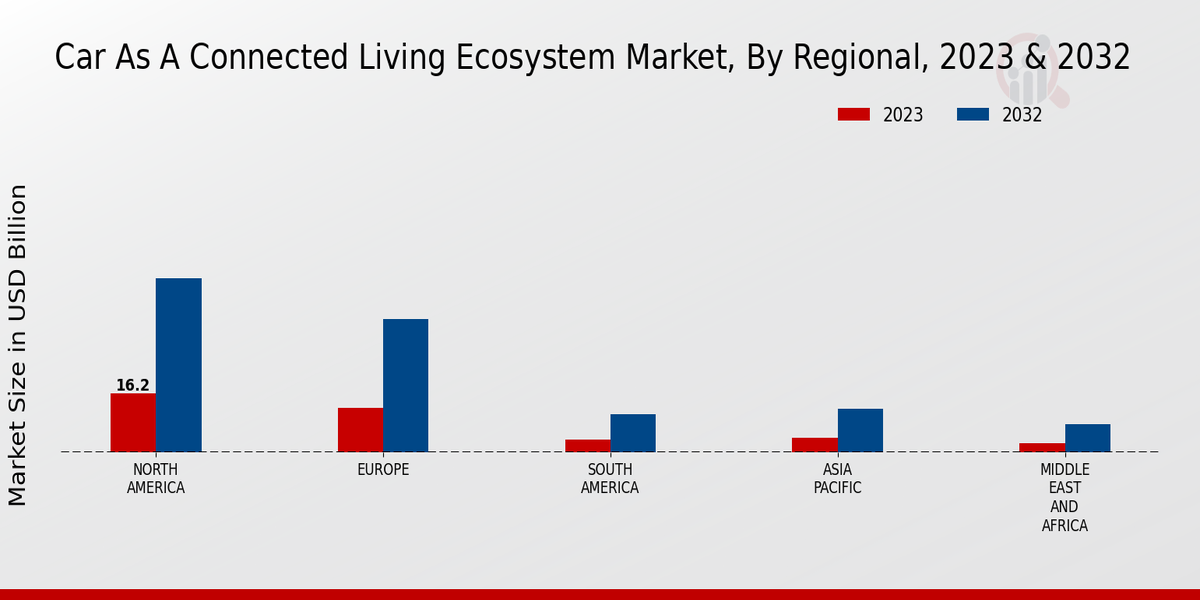Rise of Electric Vehicles (EVs)
The rise of electric vehicles (EVs) is significantly influencing the Global Car as a Connected Living Ecosystem Market Industry. As EV adoption accelerates, manufacturers are increasingly integrating connectivity features to enhance user experience and optimize vehicle performance. Connected EVs can provide real-time data on battery status, charging locations, and energy consumption, which are essential for efficient operation. This trend is expected to bolster the market, as the synergy between EVs and connected technologies becomes more pronounced. The growing focus on sustainability and innovation in the automotive sector suggests a promising future for connected EVs.
Government Initiatives and Regulations
Government initiatives and regulations play a pivotal role in shaping the Global Car as a Connected Living Ecosystem Market Industry. Many countries are implementing policies to promote the adoption of connected vehicles, focusing on safety and environmental sustainability. For example, regulations mandating the inclusion of advanced safety features in new vehicles are becoming more prevalent. These initiatives not only encourage manufacturers to innovate but also enhance consumer confidence in connected technologies. As a result, the market is likely to experience a compound annual growth rate (CAGR) of 12.87% from 2025 to 2035, driven by supportive regulatory frameworks.
Emergence of Mobility-as-a-Service (MaaS)
The emergence of Mobility-as-a-Service (MaaS) is reshaping the Global Car as a Connected Living Ecosystem Market Industry. MaaS platforms integrate various transportation services into a single accessible platform, promoting the use of connected vehicles for shared mobility solutions. This shift towards shared transportation models is driven by urbanization and changing consumer preferences, as individuals seek more flexible and sustainable mobility options. The integration of connected features in shared vehicles enhances user experience and operational efficiency, indicating a transformative trend in the automotive landscape.
Growing Consumer Demand for Smart Features
Consumer preferences are shifting towards vehicles equipped with smart features, driving growth in the Global Car as a Connected Living Ecosystem Market Industry. Features such as infotainment systems, advanced driver assistance systems (ADAS), and remote vehicle management are increasingly sought after. This trend is reflected in the rising sales of connected cars, which are expected to dominate the automotive market. The demand for these smart features is anticipated to contribute significantly to the market's expansion, with projections indicating a growth to 172.3 USD Billion by 2035, showcasing the potential for innovation in vehicle connectivity.
Integration of Advanced Connectivity Technologies
The Global Car as a Connected Living Ecosystem Market Industry is experiencing a notable surge due to the integration of advanced connectivity technologies such as 5G and V2X (Vehicle-to-Everything) communication. These technologies facilitate seamless communication between vehicles, infrastructure, and the cloud, enhancing safety and efficiency. For instance, 5G networks enable real-time data exchange, which is crucial for autonomous driving and smart traffic management. As a result, the market is projected to reach 45.5 USD Billion in 2024, indicating a robust demand for connected vehicles that leverage these technologies.
























Leave a Comment